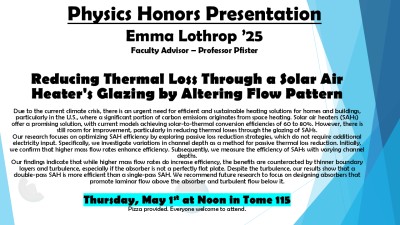May 1, 2025
Emma Lothrop '25 will present Reducing Thermal Loss Through a Solar Air Heater's Glazing by Altering Flow Pattern. Pizza provided. Everyone welcome to attend.

Due to the current climate crisis, there is an urgent need for efficient and sustainable heating solutions for homes and buildings, particularly in the U.S., where a significant portion of carbon emissions originates from space heating. Solar air heaters (SAHs) offer a promising solution, with current models achieving solar-to-thermal conversion efficiencies of 60 to 80%. However, there is still room for improvement, particularly in reducing thermal losses through the glazing of SAHs. Our research focuses on optimizing SAH efficiency by exploring passive loss reduction strategies, which do not require additional electricity input. Specifically, we investigate variations in channel depth as a method for passive thermal loss reduction. Initially, we confirm that higher mass flow rates enhance efficiency. Subsequently, we measure the efficiency of SAHs with varying channel depths. Our findings indicate that while higher mass flow rates do increase efficiency, the benefits are counteracted by thinner boundary layers and turbulence, especially if the absorber is not a perfectly flat plate. Despite the turbulence, our results show that a double-pass SAH is more efficient than a single-pass SAH. We recommend future research to focus on designing absorbers that promote laminar flow above the absorber and turbulent flow below it. Dept